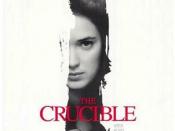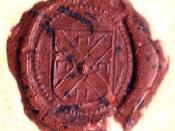In life, emotions can act as motivators for courses of action, particularly the feelings of fear, guilt and revenge. Arthur Millerâ≢s play The Crucible shows these themes put to use on a number of occasions. The playâ≢s numerous characters and relationships provide a plethora of examples where the themes are employed.
It is through their actions that their emotions and motives are revealed, aiding us in understanding the measures theyâ≢ve taken.
Fear can drive people to actions of cowardice and dishonesty. Mary Warren displays this anxiety when she allows Abigail to frighten her into abandoning John Proctor and accusing him of witchcraft. This leaves him unable to prove the girlsââ¬ÃÂE perjury and at the mercy of the judges who are quick to impose guilt. Reverend Parris also displayed an influence by fear when he urged the judges to condemn the accused and encouraged the accused to confess. He believed that this would help him continue to appear moral in the town during immoral and unjust proceedings.
Should he lose his facade of morality, he would lose his position of power as reverend. Both Mary Warren and Parris threw others in the line of fire when they had the opportunity to help, proving the negative effects fear can have on peopleâ≢s judgment.
Guilt can pressure a good person to do the right thing, showing the potentially positive effects of an essentially negative sentiment. John Proctor wanted to confess to the charge of witchcraft and live. However, he chose not to confess and tarnish the names of the remaining accused. He knew the guilt of his confession would be too great a burden to live with. Revered Haleâ≢s guilt of condemning the innocent â∠Âwitchesââ¬ÃÂEto death was his main motivator in advocating Proctorâ≢s inclination to confess. Guilt can apply much strain on the conscience of a person, hopefully with a positive aftermath.
The power of revenge can debilitate and even destroy when orchestrated properly.
Abigail produced the paramount example of revenge at work, and manifested a witch scare in Salem to punish John Proctor for rejecting her advances. Thomas Putnam also struck back at those who denied him, murdering his neighbors as witches and claiming their land. Both Abigail and Putnam share the qualities of overconfidence and deceitfulness so revenge could have been something expected of them both. The effects of their revenge tactics make the pair two of the most atrocious characters.
These compelling themes of fear, guilt and revenge will provoke people to take very extreme courses of action. It is the choices one makes that they are judged on, because your choices are dictated by the person you are. It is even oneâ≢s decision whether or not to let emotions cloud your judgement. However, once the choices are made and the outcome is witnessed your strength of character is revealed. Unfortunately it isnâ≢t always the deserving individuals that take the fall. John Proctor realized his best revenge on the guilty would be to abstain from confession and leave them with the fear that people wouldnâ≢t stand for the deaths of the innocent.
The Crucible, by Arthur Miller was about the happenings in Salem, Massachusetts in 1692. Reverend Parrisâ≢s Ten-year-old daughter Betty Parris was supposedly a victim of witchcraft. Reverend John Hale was supposed 2 determine whether Betty is indeed bewitched. Parris is mad at his niece Abigail because he found her Betty and other girls in the forest dancing. She denies that they engaged in witchcraft. Thomas Putnam and his wife entered the room with Betty present. Mrs. Putnam reports that Mr.
Collins saw Betty flying over a neighbors barn. Their own daughter, Ruth is as listless as Betty. Betty sits up suddenly and cries for her mother, but her mother is dead and buried.
Abigail tells her that she told Parris everything. Betty cries that Abigail did not tell Parris about drinking blood as a charm to kill Elizabeth Proctor, 's wife. Abigail strikes the child across the face. She turns to the other girls and warns them to confess only that they danced and that Tituba conjured Ruth's dead sisters. She threatens to kill them if they breathe a word about the other things they did. She shakes Betty, but the child has returned to her unmoving, unresponsive state.





